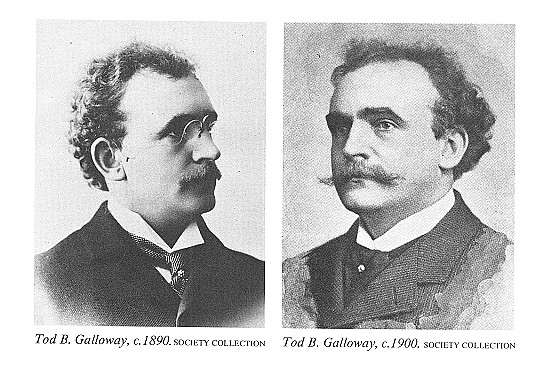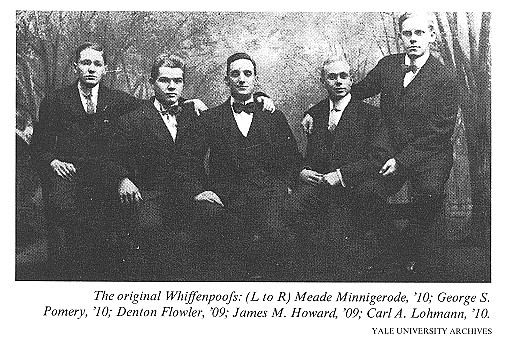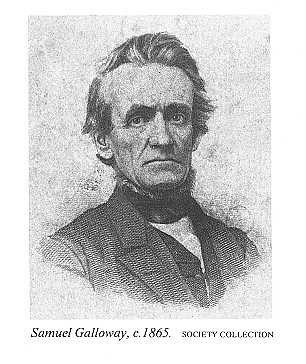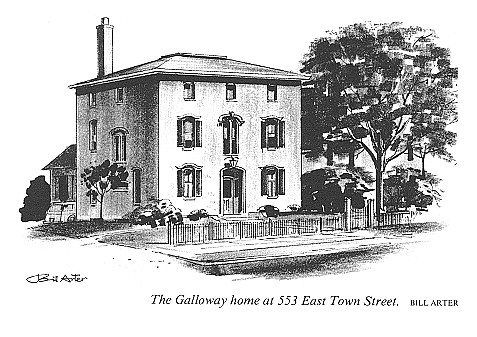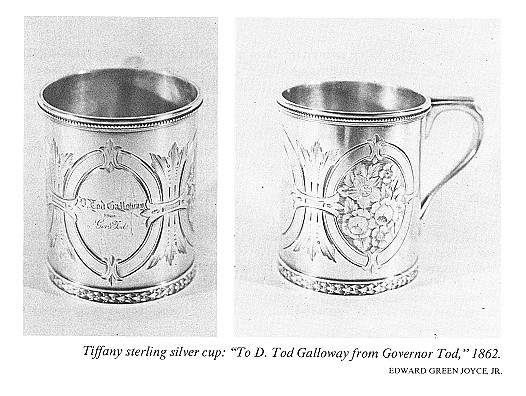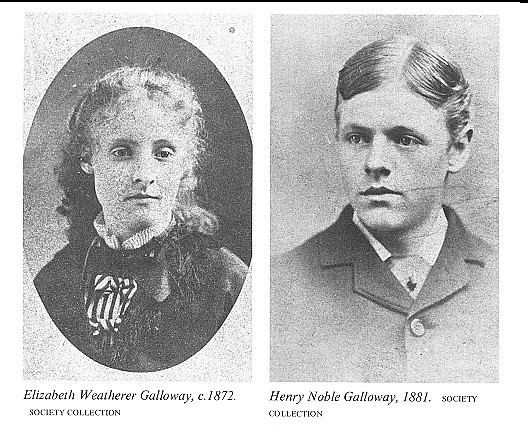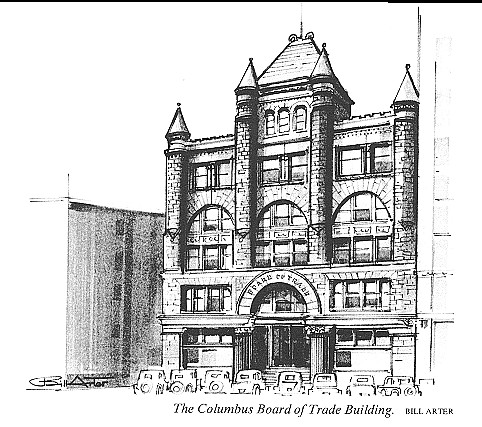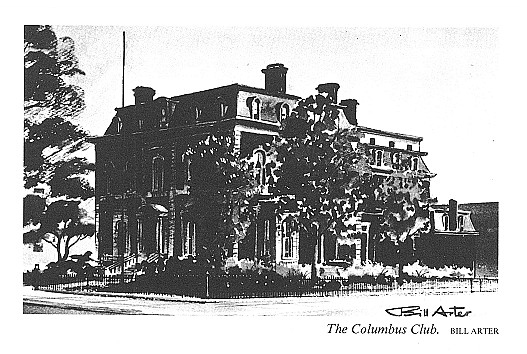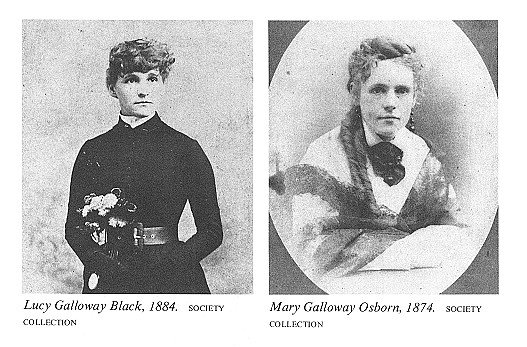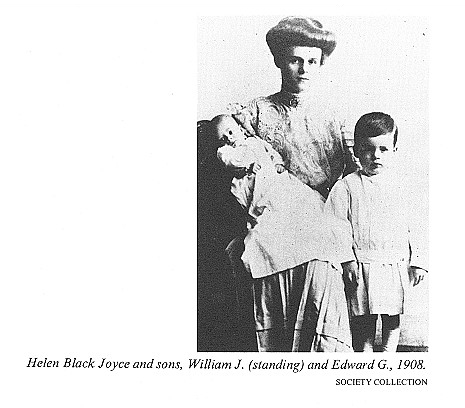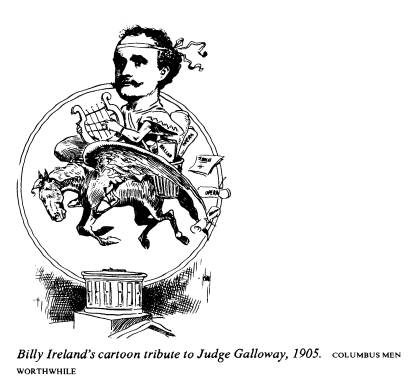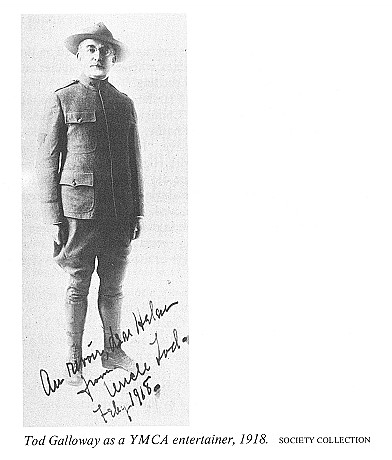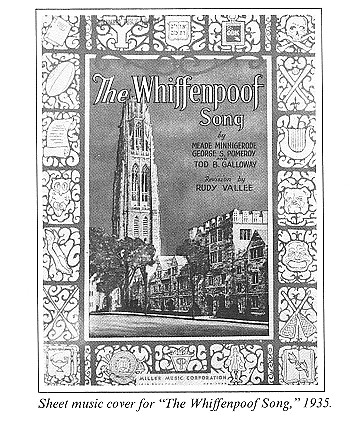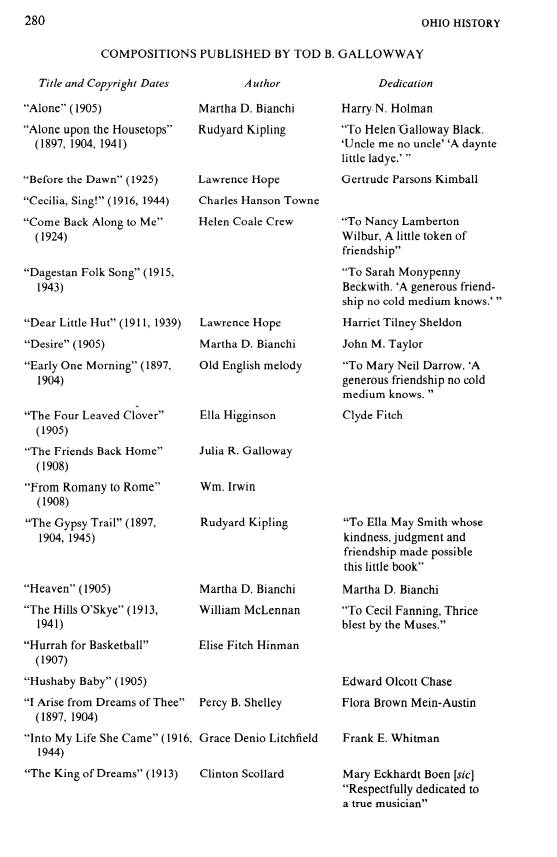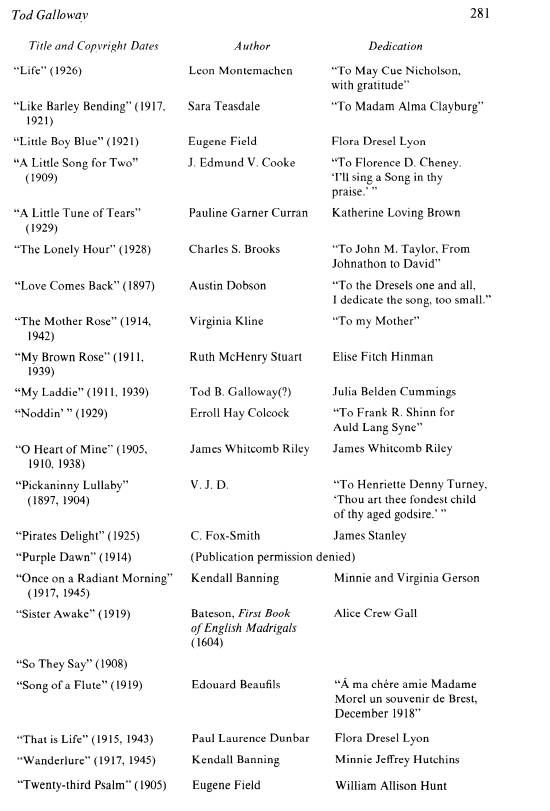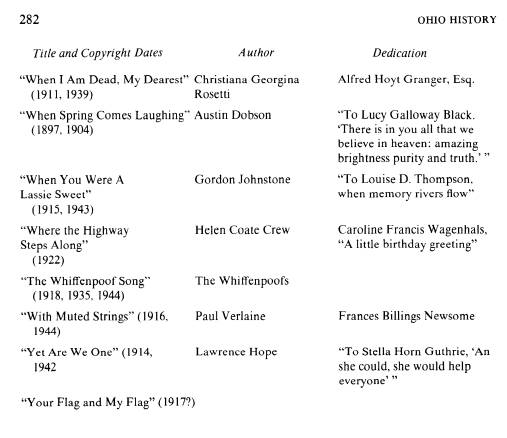Ohio History Journal
RICHARD THEODORE BOEHM
Tod B. Galloway:
Buckeye Jongleur, Composer of
"The Whiffenpoof Song"
How did the music for Yale's famous
"Whiffenpoof Song" come to be composed by
an Amherst College grad in Central Ohio?
And how did the Columbus tune come
to be matched to a New Haven college
verse, thence grow to become a part of the
common heritage of the world of American
music?
The answers emerge from a varied skein,
starting with homesick British soldiers
serving in Victoria's India, tracing to
Central Ohio and the pastime talents of a col-
orful Columbus
judge-musician-entertainer, thence on to Connecticut through the
musical lives of five Yale University
students. Throughout the tangle, the mark of a
popular Buckeye musician is indelible.
The threads all came together in Colum-
bus: the time was New Years Night, 1908;
the place, the Columbus Club.
The concert that evening by the Yale
Glee, Banjo and Mandolin Clubs was "the
best ever given here by a college
club," reported the Ohio State Journal. The per-
formance at the Board of Trade
auditorium was an enthusiastic success enjoyed by
a "large and fashionable audience.
. ." which included "the social element in large
numbers." The Journal methodically
set out a roster of thirty-seven "patronesses,"
alphabetically arranged; the list was
studded with family names from the upper
strata of Columbus society, many of them
with Yale connections.
The third number on the club program was
Tod Galloway's popular "Gypsy
Trail," composed more than ten
years earlier. It was sung by Yale's soloist, Phillip
Hamilton Collins, a senior from
Cleveland, who, the critic adjudged, had a "smooth
baritone voice of splendid quality, and
he was most successful with this song. It
was very well received, and Judge
Galloway, who was in the audience, must have
been very happy over its
reception." 1
After the concert, the glee clubbers
moved a couple of blocks east on Broad Street
to the Columbus Club (still today a
fashionable uppercrust club), where "a delight-
ful smoker" was sponsored by the
Yale alumni for the twenty-three choristers. Gal-
1. Ohio State Journal (Columbus), January 2, 1908. See also Columbus Evening
Dispatch, January 2,
1908; Yale Daily News, December
13, 1907. Galloway applied to himself the term "jongleur," which, he
said, was a medieval French word used in
France and Norman England. A jongleur was a minstrel who
traveled 'from place to place, singing
songs, often of his own composition and usually to his own accom-
paniment.' "The Trail of a
Jongleur," The Etude (February 1929), 95.
Mr. Boehm, a Columbus lawyer, certified
public accountant, and lecturer in law, has been a contrib-
utor to more than a dozen leading
technical journals.
|
loway, already credited with almost a score of published musical compositions, en- tertained the visiting songsters in his popular solo style. He played for them his own rendition of the refrain from Rudyard Kipling's "Gentlemen-Rankers." The Yale guests all joined in singing the words set to the Ohioan's catchy tune:
We're poor little lambs who've lost our way, Baa! Baa! Baa! We're little black sheep who've gone astray, Baa-aa-aa! Gentlemen-rankers out on the spree, Damnedfrom here to Eternity, God ha' mercy on such as we, Baa! Yah! Bah! They sang the chorus again, and they sang it yet again. One of the gleemen later re- counted for the record that three choruses were sung by the audience after Gallo- way had taught them the now-famous tune. The reprise from the Columbus Club still runs on, into the days of our years. The Judge's melody as the setting for Kipling's verse made a lasting impression on the young singers. When they got back to New Haven, five of the clubbers gath- ered to harmonize. Years later, "Caesar" Lohmann, baritone in the Varsity Quar- tette, one of the five founders of the Whiffenpoof Club, retold the Columbus story of "The Whiffenpoof Song":
The tune was suggested in a song sung for them by Tod Galloway, Amherst, '85, sometime Judge of Probate Court of Franklin County, Ohio. The original Whiffenpoofs had met him after a concert in Columbus which he attended because one of his compositions was on the Glee Club's program. Afterwards he entertained them by singing some of his unpublished songs, among them a setting of Kipling's Gentlemen Rankers. They remembered it with pleasure and in casting about later for an anthem, found it admirably suited for their pur- |
|
pose. The [Kipling] chorus needed only the change of a word-"rankers" to "songsters." 2 The five founding Whiffenpoof singers-all at Columbus that night-were Meade Minnigerode, George S. Pomeroy, Jr., James M. Howard, Denton "Goat" Fowler, and Carl A. "Caesar" Lohmann. Lohmann drew up a crude constitution for the club and a few simple membership rules. Monday at Mory's Temple Bar, at six, was fixed as the regular singing date. Thus a year later, in January 1909 was born the Whiffenpoof Club, and its anthem designated. Kipling's verse, Galloway's tune, Yale's traditions, the clubber's poetic revision and the captivating voices of the singers all combined to produce the popular college song which became a per- manent part of Yale life, its reprise perpetuated by generations of students who gathered each week to hear the Whiffenpoofs sing.3
2. Rudyard Kipling's Verse, Definitive Edition (New York, 1940), 422-423. Carl A. Lohmann, "The Whiffenpoof Song" from one segment of a large collection of materials about the Whiffenpoofs. Arnold G. Dana, comp., Yale Old and New (n.p., 1932-1943), L, available only in the reference department, Yale University Archives, Yale University Library. 3. All of the five singing founders of the Whiffenpoof Club were on the Yale Glee Club trip of 1907-1908 and presumably were in Columbus on New Years Day 1908. (There were two non-singing founders as well.) Two members, both of the Yale class of 1910, were the author of the Whiffenpoof verse: Meade Minnigerode (1887-1967), of Essex, Conn., later a prolific writer for such popular maga- zines as Saturday Evening Post, Colliers, and Ladies Home Journal, and author of a score of books, and George S. Pomeroy, Jr. (1888-1964), of Reading, Pa., later a tycoon of an eastern Pennsylvania depart- ment store chain. (These two received royalties as authors of the Whiffenpoof verse.) The other three founders included James Merriam Howard (1886-1971), Yale, 1909, a longtime Presbyterian clergyman, Carl A. Lohmann (1887-1957), Phi Beta Kappa scholar, LL.D., Yale, 1910, a native of Akron, Ohio, a World War I veteran, a lifetime career administrator, secretary of Yale University, and Denton "Goat" Fowler (1886-1910), Yale, 1909, who was killed by gunshot during a payroll robbery in 1910. Of his per- formance in Columbus, the Ohio State Journal said, "The hit of the evening was made by Mr. Fowler. Here is a young fellow who is a natural comedian, and if he ever happens to go on the stage he will be heard from." January 2, 1908; pamphlet, "A History of the Whiffenpoofs ... Prepared for the 60th An- niversary Celebration, February 22, 1969" (Yale University, New Haven, Conn., n.d. n.p.); National Cyclopedia of American Biography (New York, 1961), XLIII, 382. |
|
|
|
The young Whiffenpoofs were sure they had wrought well. Pleased by the magic of their singing, they set into their club constitution-and promised never to permit amendment-the euphoric command that "Whiffenpoof Song" be sung "all stand- ing" and that "under no consideration [may it] be sung at any other time or place." 4 The last vestage of this strict standard and tight monopoly disappeared thirty years later when Yale-grad radio star Rudy Vallee promoted the lovely tune, adorned with his own new arrangement, into radio's big time hit parades. The composer of the Whiffenpoof melody never guessed the climax of this tale. Judge Galloway died in 1935, seventy-two years of age. Not until the next year did the biggest things begin to happen to "Whiffenpoof Song." But what of the Buckeye singer? What manner of man was this handsome, dis- tinguished looking, entertaining, personable bachelor, he of the aristocratic pince- nez glasses and the lovely second-tenor voice? When came the muse which made him the ranking idol of the Columbus evening set? He was, as the saying goes, "quite a guy." Tod Buchanan Galloway came from demonstrably good stock. Two ancestors served in the American Revolution. His father, Samuel (1811-1872), of Scottish descent, was a cousin of President James Buchanan. Samuel graduated at the head of his class from Miami University at Oxford, studied law and theology, taught Greek and classical languages, was admitted to the Ohio bar in 1842. After two years of law practice in Chillicothe, he was elected secretary of state (1844-1850), whereupon he moved to Columbus. Galloway took pride that he had greatly ex- panded the work of the secretary's office in furthering the public school system. Elected to Congress (1855-1857), he participated as an antislavery Whig. De-
4. The Whiffenpoof constitution explicitly commanded that the words of the song be sung to the tune of "Gentlemen Rankers." Section I, article 4; Section II, article 6. The constitution in full is contained in the depositions in Miller Music, Inc. v. G. Schirmer, Inc., Equity Case E85-227, U.S. District Court, Southern District of New York; a full copy is on file, Tod B. Galloway Papers, Ohio Historical Society. |
|
feated, he returned to the practice of law, campaigned for Abraham Lincoln, re- jected appointment to public office, although he served as judge advocate at Camp Chase and as secretary to Governor David Tod (1861-1863). In 1872 Galloway un- successfully sought the Republican nomination for governor. All the while a respected Columbus lawyer, Congressman Galloway was a recog- nized civic leader, trustee of Capital University, and in 1861 received an honorary LL.D. degree from Indiana University. It was said that he was an accomplished public speaker with a charming, witty platform manner. He developed Galloway, a village in Prairie Township, a few miles west of Columbus. A small cemetery and a county road near the village, a downtown Columbus alley and an eastside avenue still carry the Galloway name. The family lived at 553 East Town Street (near Par- sons Avenue, then East Public Lane) in a classic brick house built by Samuel in 1852, subject of one of the elegant Bill Arter Columbus Vignettes in 1966. Samuel Galloway died in 1872. He committed his "soul by faith to Christ my Redeemer and commended [his] family and friends to His precious love and care." The tall, imposing family tombstone in a stylish section of Green Lawn Cemetery boldly proclaims "Resurgam. "5 Ample resources were on hand to rear several or- phaned children and support his widow in a comfortable "carriage-trade" style. His not small estate included real property in Michigan and Louisiana, in Colum- bus, and in Prairie and Truro townships. Twenty-three years after he died, a ful- some eulogy of his career, along with special recognition as a founding member of Westminster Presbyterian Church, was preached and then published by Washing- ton Gladden, famed Columbus minister.6 Tod Galloway's mother had talent and ability which, he later said, had great ef- 5. Bill Arter, Columbus Vignettes (Columbus, 1966), [I], 84; first published in Columbus Dispatch, No- vember 21, 1965; Ella Lonn, Desertion During the Civil War (New York, 1928), 96. For a short treatment about this fascinating man, see "The Legacy of Bill Arter," Ohio State University Monthly (July 1973), 16. 6. Will of Samuel Galloway, Franklin County Probate Court, Will Record F (1872), 225; Washington Gladden, "Samuel Galloway," Ohio Archaeological and Historical Quarterly (1896), IV, 263-278. See also Biographical Directory of the American Congress, 1774-1961 (1961), 925; A Centennial Biographical History of Columbus and Franklin County, Ohio (Chicago, 1901), 184-187; and William Alexander Tay- lor, Centennial History of Columbus and Franklin County, Ohio (Chicago, 1909), I, 534-536. |
Tod Galloway 261
feet on him as a blooming youngster.
Born in Cincinnati, Joan Wallin (1821-1892)
was educated there at Stoughton's Young
Ladies Seminary. As a student, she ex-
celled in music and French. Shortly
after graduation, she served as a teacher in Dr.
Sanis' School for Young Ladies in
Hillsboro. One time when Samuel came to Hills-
boro to visit his sisters, in attendance
at the school, he met Miss Wallin. Her future
husband was ten years her senior; they
were married when she was eighteen.7
In his last years, Tod wrote with
evident pride about his mother's broad culture,
her fund of humor, her brilliance in
conversation, her fine French language and mu-
sical ability. Galloway's latter day
letter was also an apt description of their lovely
Italianate house and their way of life:
A large, square house with an ample ell.
A home of high ceilings, broad hallways and spa-
cious rooms, of big windows with
old-fashioned outside shutters and a broad winding stair-
way leading to an attic which covered
the entire third story. An attic where were numerous
bound volumes of old newpapers which
contained a rare delight-advertisements of Van
Amberg's Wonderful Show, Jenny Lind and
Tom Thumb, Smithsonian Reports, Perry's Ex-
pedition to Japan and the Exploration of
the Amazon River. Another place of delight was
the big, cool cellar with rafters hung
with strings of onions, peppers and all things so placed
for drying.
Around the walls were barrels of apples,
potatoes, molasses, vinegar, and cider; while a
generous swinging shelf held hams,
tongue and fresh vegetables from the farm. In one part
was a sunken place in the floor lined
with stone slabs where with fresh water, the milk and
cream could be kept cool and sweet. Ice
packed in sawdust was always kept in an icehouse.
This plenteous supply of provender was
indicative of the open-handed hospitality of the
home through which passed a constant stream
of guests-one day, the most distinguished;
the next, plain and humble. A United
States senator, often; and often visiting politicians, a
stump speaker or a county chairman....
Spacious grounds surrounded the house
filled with all kinds of trees, cedar, maple, silver
leaf poplar, fruit trees of all kinds,
including six apricots-a rare tree in central Ohio...
Then there was the generous barn or
stable near which stood the ash barrels where the soft
soap for the laundry was made. The
cow-barn-for no one depended upon dairies-and the
chicken yard were near by, for then
families had to be independent of butchers and bakers
and candle-stick-makers....
Columbus in the 60's and 70's was a
charming little city emerging from the Civil War. Its
broad trees, unpaved streets and
cobblestone gutters, its stone hitching posts and carriage
steps and its general air of hospitality
and manners made it seem quite Southern in charac-
ter. One evidence of this was the way
many of the ladies did their shopping. It was called
"carriage shopping." A lady
would drive in her carriage to the stores she frequented and
obliging clerks would bring out bolts of
silk, muslin, or whatever articles she wished to in-
spect-she not leaving her vehicle....
Sunday newspapers had not appeared but
religious papers such as the Herald and the
Presbyter and the Christian Union (later
the Outlook) were reserved for Sunday perusal.
There were always family prayers .... My
mother was broadly cultured with a fund of hu-
mor, brilliant in conversation on all
subjects, a fine French scholar and accomplished musi-
cian. I can well remember her
hand-copied books of thorough bass. When Oscar Wilde
was in this country in the late 80's he
remarked that next to Lady Stanley, my mother was the
most brilliant conversationalist he had
met.8
Tod Galloway was the youngest of ten
children, all Columbus bred, only five of
whom survived to reach adulthood. He was
born when his accomplished father
7. Gladden, "Samuel Galloway";
see also Ruth Young White, ed., We Too Built Columbus (Columbus,
1936), 101-102.
8. Ibid.
|
was fifty-two years old, when Congressman Galloway was serving as private secre- tary to the governor, who lived across the street. To celebrate the occasion, the in- fant was given a handsome sterling silver cup from Tiffany's of New York, beauti- fully decorated, inscribed "D. Tod Galloway from Governor Tod." The lad was not yet nine years old when his father died; he grew up with his mother, who had her own full cup of sorrow. A few months after Congressman Galloway died, Elizabeth Weatherer Galloway, the second daughter, died at age eighteen. The next year, John S. Galloway, the eldest son, almost twenty-two, freshly graduated from college, while visiting a new blast furnace in the southend, was badly mangled in an elevator accident. After a day of suffering, he died from his injuries.9 Henry Noble Galloway, the second son, named for a distinguished Columbus lawyer who later became his preceptor, was graduated at Amherst College in 1881, and the next year he was admitted to the Columbus bar. When his health failed, he moved in 1883 to Los Angeles to practice as an attorney and abstractor of titles, all the while hoping to regain his health in the California climate. An urgent message in 1887 from Henry's physician summoned Mrs. Galloway and Tod, newly home from Amherst, to Los Angeles. Henry's condition became much worse. The three started back to Columbus, but Henry died enroute, at Las Vegas, New Mexico, in May.10 Tod had followed his older brother, Henry, to Amherst. At college he formed a
9. Ohio State Journal, November 9, 10, 1873; the Tiffany cup is in the possession of Edward Green Joyce, Jr., of Columbus, grandson of Helen Black Joyce, Tod Galloway's niece. The Ohio Historical Society and the author are indebted to Mr. Joyce for his assistance and for making available numerous family photographs. 10. Ohio State Journal, November 9, 10, 1883; May 26, 27, 1887; Amherst College vita of Henry Noble Galloway (1858-1887). |
|
life-long friendship with a classmate, Frank Ellsworth Whitman (1862-1946), later a perennial class secretary, high-ranking business executive, still a helping friend forty years later. Tod's roommate was Clyde Fitch (1865-1909), who went on to become a leading American playwright. In his junior year, Tod went to New York with Fitch, on vacation, and managed to go to eleven plays in six days. They were both members of Chi Psi Fraternity at Amherst.11 Galloway later dedicated published melodies to both Whitman and Fitch. Graduated with honors in 1886, Tod returned to the family homestead. After reading law with Messrs. Nash and Lentz, distinguished Columbus lawyers, Tod, the second Galloway son to follow their father's profession, was admitted to the Ohio bar in 1888. He traveled in central Europe in 1892 and methodically put to- gether a hefty scrapbook collection of postcards. Practicing law with his preceptors from an office in the Board of Trade building, he also became Republican county chairman in 1893, and president of the Buckeye Republican Glee Club. Occasion- ally the club rehearsed at the family residence on Town Street. He became Colum- bus city councilman for the Seventh Ward (the "Silk Stocking Ward") in 1894-1895. "Judge," his complimentary title, and indeed a lifelong nickname, was earned dur- ing two terms as a Franklin County Probate Judge (1896-1904). As an extra activ- ity, he organized a traveling free library for the county schools in Franklin County and, in 1904, wrote to Andrew Carnegie, soliciting his interest in the project and a
11. For a biography of Frank E. Whitman, see National Cyclopedia of American Biography (1948), XXXIV, 537. That Galloway was Fitch's roommate was mentioned in one obituary. New York Times, December 16, 1935. |
|
major contribution for its support.12 His workaday career as a probate judge induced a stage hit in which he became an unwitting model. As a raconteur, the Judge told his college buddy, Clyde Fitch, then a New York playwright, about a juvenile who had come before the Probate Court. Fitch used the episode as the nucleus of a Broadway play, The Girl and the Judge (1901). This inspired comedians Joseph M. Weber and Lewis Maurice Fields to produce a comic parody called The Curl and the Judge. Fitch's chroniclers retold the story in detail: "The Girl and the Judge" was always called by Fitch his Taormina play, because most of it was written there; it was also called "Tod's play," because Judge Galloway had told him a court story which had come under his notice while he was a probate judge in Franklin County, Ohio. The plot was based on a human incident said to be the case of Ikey Einstein, probably a fictitious name. The incorrigible boy had been brought to court again and again
12. George Kilbon Nash (1842-1904) was governor of Ohio, twice attorney general, twice prosecuting attorney of Franklin County. Robert H. Bremner, "George K. Nash, 1900-1904," in The Governors of Ohio (Columbus, 1954), 136; Centennial Biographical History, 186-187. John Jacob Lentz (1856-1931), Columbia Law School, 1883, and admitted to the Ohio bar, 1883, practiced in Columbus with Governor Nash and (later) John Delano Karns, until 1915, when his job as president of the American Insurance Union effectively precluded daily general practice. He had earlier served as a Democratic representative to Congress (1897-1901). Biographical Directory of the American Congress, 1774-1961, p. 1211; Osman Castle Hooper, History of Columbus, Ohio (Columbus, 1919), 318-320; William S. Taylor, Ohio in Con- gress (Columbus, 1900), 310; Tod B. Galloway to Andrew Carnegie, January 28, 1904, Box 14, Herrick Letterbook, p. 43, Myron T. Herrick Papers, Ohio Historical Society. |
Tod Galloway 265
by his mother; she sought to have him
committed to a reformatory, one of her particular rea-
sons being that his conduct interfered
with her daughter's matrimonial prospects.
Ikey was an old offender in the
Children's Court, yet each time, when it came to the mo-
ment of sentence, the old woman would
weaken and beg him off. But one day, after a par-
ticularly harrowing plea to have him
"sent up," the Judge told the mother firmly that this
time Ikey must feel the full rigor of
the law. To this Mrs. Einstein readily agreed. So sen-
tence fell upon the boy's head; he was
lectured soundly by the Court and ordered to serve a
term in the Reformatory. The fat old
woman threw herself on her knees, to the astonish-
ment of the Judge, her body swaying back
and forth, and with outstretched hands, she cried
distractedly, "Oh, Ikey, Ikey! get
down on your knees and maybe you can soften the hard
heart of the Judge!"
This story particularly appealed to the
humor of Clyde Fitch, and he wrote to Judge Gal-
loway: "I have put you and your
Court into a play." But the central plot dealt with a klepto-
maniac mother of the "girl,"
the Judge being the hero.13
A major new period in Galloway's life
began in 1904 when, in January, he left the
courthouse and moved upstreet to the
Statehouse as personal secretary to Ohio's
Governor Myron T. Herrick, during a two
year term (1904-1906). From the first
week, Galloway was immersed in a
staggering volume of the governor's correspond-
ence, much of it merely trivial.
Patronage problems came soon and often; convicts
sought relief and were told to follow
normal channels; churches and charities seek-
ing handouts needed to be turned away;
and explanations were sent to excuse the
governor's inability to appear for
speeches. Galloway handled several dozen rail-
road passes for the governor's use in
those days before legal prohibitions stopped
this practice and rescued the carriers
from widespread patterns of shakedowns by
politicians. The secretary soon came to
feel secure enough to criticize Amherst Col-
lege, his alma mater, for failing to
recognize Clyde Fitch, and for being "entirely too
local in its recognition of her sons
.... Here in Central Ohio, we hardly ever hear her
name any more ... [but I am] devoted to
Amherst and its interests...."14
Three weeks after he moved into the new
job, Galloway received from Delevan,
Wisconsin, a letter from a lady
soliciting help for her father, a resident of Colum-
bus:
When I was quite a child one day, after
interpreting for my mother at the Court House, you
took me on your lap and said something
about my being a sweet child, then added, "If you
ever ask a man to marry you and he
refuses, come and ask me." Now, being satisfied with
teaching... I have not found any use for
what you said; but cannot it be turned in another
way? My father-a deaf man-wants a
position .... Wont you help? ... if you will just get in
a few words, Father will have the
position [as extra clerk] and I shall not have to take advan-
tage of your promise even if it is leap
year.15
The governor's secretary often covered
for his boss, making numerous speeches,
including appearances at the opening of
historical sites. Galloway also participated
extensively in the election campaign of
1905. One of his campaign arrangements
13. William Clyde Fitch (1865-1909) was
said to be "America's most successful playwright." Mon-
trose J. Moses and Virginia Gerson, Clyde
Fitch and His Letters (Boston, 1924), v, 207-208. On numer-
ous occasions, he had several hits
running at the same time. See also Dictionary of American Biography
(1958), III, 428-429; Montrose J. Moses,
The American Dramatist (Boston, 1925), 309. The Weber and
Fields parody was mentioned in Felix
Isman, Weber and Fields (New York, 1924), 280-284.
14. Galloway to Henry E. Whitcomb,
January 19, 1904, Box 14, Herrick Letterbook, p. 221, Herrick
Papers.
15. Letter to Galloway, January 20,
1904, Box 1, folder 3, ibid.
|
produced a free traction car for Herrick's use for political stumping in western Ohio.16 The governor, however, was defeated by John M. Pattison, a reform candi- date. When Herrick's term of office in the Statehouse ended in early 1906, Gallo- way returned to a lacklustre practice of law in Columbus. He served in business as the secretary of an insurance company. Four years later, in 1910, he went to New York. Galloway, dressy bachelor, ladies' man, scintillating singer, stage-center solo en- tertainer for thirty years, would have loved to tell his own story. He lectured, wrote dozens of serious articles, usually on music. He dabbled in history, loved to re- search the past, belonged to the Ohio Historical Society as a life member, to the Old Northwest Genealogical Society, the Sons of the American Revolution, to the Co- lumbus Club for twenty years, and to the Ohio Society of New York. But music was his main joy; he performed often, his own and anybody's. In later life, he put these all together and became an accomplished writer of articles on music history. Popular Judge Galloway lived in the old family residence with his gifted mother. When she died in 1892, her three remaining children promptly put the house into the name of Lucy Galloway Black, her second daughter. Thereupon Lucy and her husband, William, a railroad official, and their daughter Helen, returned from Chi- cago and took up residence in the classic homestead. The oldest sister, Mary Os- born, died soon afterward, leaving only Lucy and Tod surviving. For another dec-
16. Only two years later both the Federal and Ohio legislatures outlawed the free railroad pass for pub- lic officials. The Hepburn Act, 34 Stat 584 (1906), now 49 U.S. Code sec. 1 (7) (1952), and an Ohio stat- ute, 98 Ohio Laws 347 (1906), now Ohio Revised Code sec. 4907.30 (1953), forbid this practice. In the wake of the reform movement, the Interstate Commerce Commission rescued all the carriers from their less ethical competitors and the subtle pressures from men in public life. Colorado Free Pass In- vestigation (1913), Interstate Commerce Commission Report, XXXVI, 491. To the extent that railroad passes were considered to be political contributions, they were also forbidden by the Tillman Act of 1907, Public Law 59-36, 35 Stat. 864, now 18 U.S. Code sec. 610 (1972), by the Hunt Act in Ohio, 113 Ohio Laws 307, 400 (1908), now Ohio Rev. Code 3599.03 (1953), and by laws enacted in dozens of states. R. T. Boehm, "Taxes and Politics," Tax Law Review, XXII (March 1967), 369-438. |
|
ade Judge Galloway resided with Lucy's family, until 1902 when the Town Street house was foreclosed by a mortgage creditor. The Blacks' daughter was a handsome, teenage "daynty little ladye" (whom the Judge so complimented in a song dedication). Helen's close chum, Grace B. Kel- ton, a neighbor who lived in a stately mansion across the street came and went in the Black-Galloway household countless times. Miss Kelton remembered that, during her teenage days, Tod was at the upright piano a great deal of his time, sing- ing, playing, working on chords and progressions, phrases and verses, diligently composing melodies. Music for him came easy, Miss Kelton recalled as a non- agenarian, and he had a wide variety of selections. Galloway would play untiringly for his friends, and often just for himself, she said, and there was always music in the house. A cousin, related through Mother Galloway's family in Hillsborough, remembered the Galloways in the stylish Town Street manse: "Evenings I have sat in the old family library, listening to Tod Galloway trying his songs and melodies on the families and neighbors. His voice through the open windows was always a wel- come invitation. His audiences were many, and gay!" 17 The Judge wrote that he had no formal training in music theory or composition. He played piano by ear. Taking a likely verse from some well-known poet, he would patiently experiment till he produced his own musical setting for the words. The music for his two biggest hits-"Gypsy Trail" and "Whiffenpoof Song"-were arrangements using poetry by Kipling (with whom Galloway was slightly ac- quainted), a turn-of-the-century favorite. Other songs were based on verses chosen
17. Grace B. Kelton, born in Columbus, August 3, 1881, told us fondly that she was a neighborhood buddy, from childhood on, of Helen Galloway Black (1882-1957). "Keltons Stately Mansion," built by her grandfather, Fernandez Cortez Kelton (1812-1866), Columbus merchant, was the subject of an affec- tionate treatment by Bill Arter, Columbus Vignettes, 72. On November 29, 1974, Miss Kelton deeded the venerable residence, an 1852 jewel, for museum and cultural purposes. DB 3444, p. 285, Franklin County. Capital University plans to take over the day-to-day operation, subject to various contingencies. Samuel G. Hibben (1888-1972), a Galloway cousin, to Ben Hayes, Columbus Citizen-Journal, October 23, 1961, copy in Galloway Papers. |
|
from Shelley, James Whitcomb Riley, Lawrence Hope, Kendall Banning, Sara Teasdale, Austin Dobson, and Eugene Field, among others. But to ready a song for final manuscript, Galloway relied upon trained musicians to produce the formal publications, almost all handled through the Theodore Presser house, then of Phila- delphia. Invariably, he dedicated his published songs to a friend. Tod's chief loves were his sister, Lucy Black and her daughter, Helen. Lucy too was interested in music and dramatics as a performer. To each of them he dedi- cated a published song. Ben Hayes, current chronicler of Columbus citizenry, in 1958, reported nuggets gleaned from Helen Black Joyce about her uncle's ways: "He was the soloist at one time or another with every musical organization in town. But you would call him a parlor singer. Uncle John Taylor would play the piano, and Galloway would sing-that guaranteed the success of any party." 18 The musical history of Columbus is studded with reports of his activities. For the gala Franklinton Centennial Celebration of 1897, a notable exercise in organized civic nostalgia, he was chairman of the music committee and a member of the exec- utive and the invitations committees. He belonged to and performed repeatedly for the Women's Music Club. He sang with the Columbus Maennerchor for at least a decade, served on four committees of the fiftieth anniversary celebration, and was the featured toastmaster at the gala golden anniversary dinner in 1898.19 He di- rected Columbus plays and operas, lectured to music and literary clubs, sang tenor solos, and composed songs. Club notices indicate a wide variety of appearances
18. Ben Hayes Column, Columbus Citizen, December 28, 1958. 19. Galloway's picture and name appeared in the Golden Jubilee souvenir program of the Columbus Maennerchor (1898) and in the club's display pictures of 1898 and 1908. Maennerchor also published my short appreciation, "Tod B. Galloway," in the 125th anniversary publication, A Return to Yesteryear (Columbus, 1973), unpaged. |
|
|
|
over a period of twenty years. In his last days, Galloway became a recognized member of the American Society of Composers, Authors and Publishers. In 1904, his accompanist was Elise Fitch Hinman, clubwoman and editor of the women's page of the Ohio State Journal.20 Galloway's activities attracted the praises of the Columbus press: Billy Ireland, fabled Columbus cartoonist, in 1905 published a complimentary cartoon. Johnny Jones, peddler of homespun nostalgia, wrote an adulatory paean in 1948; and Ben Hayes wrote a more sophisticated article ten years later. The Judge was so popular among the distaff set that, a quarter century after it happened, a Columbus lady still remembered that when Tod moved to New York, the ladies organized a party to be- moan his departure.21 Galloway's popularity in Columbus musical circles spread to the national scene. His national music reputation began as the consequence of a hearing in the Frank- lin County Probate Court, the Honorable Tod B. Galloway presiding. An aging lady had been brought before the Judge to determine whether she should be com- mitted to the hospital for the insane. The evidence did not support the proposal and the application was denied. Afterward, the defendant, a skilled musician, in gratitude, transcribed and arranged seven Galloway melodies for his first pub- lication. The lady, of whom this pleasant-ending story was later told by Galloway, took the initiative and got them published in Philadelphia in 1897 by Theodore 20. George S. Marshall (1869-1957) (mayor of Columbus, 1910-1911, longtime Columbus lawyer), The History of Music in Columbus (Columbus, 1956), 176. The Marshall list of appearances is far from com- plete. See also White, We Too Built Columbus, 101-102. Elise Fitch Hinman, to whom Galloway dedi- cated "My Brown Rose" in 1911, wrote the words for "Hurrah for Basketball," published locally in 1907. 21. Columbus Dispatch, December 5, 1948. Jones relied heavily on information furnished by Helen Joyce, Galloway's niece, who, Jones said, was "an exceptional beauty." Several inaccuracies can be ob- served in the Jones article. The Ben Hayes article was published in Columbus Citizen on December 28, 1958. See also White, We Too Built Columbus, 101-102. |
270 OHIO
HISTORY
Presser's leading music house. They were
released together as Seven Memory
Songs, characterized a half-century later by critic-historian
Sigmund Spaeth as "a
charming set." 22
"Gypsy Trail" (1897), one of
the seven, was based on Rudyard Kipling's classic
ballad. The song became a widespread
favorite, was acclaimed by Etude as "a
great success" along with the
"pronounced success" of other songs which came later.
Etude trumpeted Galloway's "extraordinary melodic
gifts." "Trail" became Law-
rence Tibbet's classic; the tune was
also used as a North Carolina college class song,
and in 1969 it was newly republished and
acclaimed as one of the Songs That
Changed the World.23
Galloway's second group of seven, called
Friendship Songs, were published in
1907 by Theodore Presser. Included in
this were "O Heart of Mine" (1905), based
on a verse by James Whitcomb Riley, and
"The Twenty-third Psalm" (1905), one of
the few plainly religious titles in his
known repertoire. His music was coming off
the presses for many years to follow.
Fifty published numbers have been identi-
fied; in his obituary he is credited
with twice that many. (See the end of this article
for an alphabetical listing of
Galloway's published tunes.)
We know that Galloway's departure was
Columbus' loss, but we cannot establish
that his presence was necessarily a
distinct gain for New York City. The available
evidence does not tell us what happened to
him in Manhattan in the decade of the
'teens. There is a strong trace of his
presence in Philadelphia in 1912. Several mu-
sical compositions date from the period,
and his Amherst College vita inconclusively
says that he was practicing law in New
York and Columbus and that he served on a
draft board in World War I. Little other
proof of his whereabouts can be found ex-
cept the vague summary that he was
engaged in editorial work at the Macmillan
publishing house. What that means, we do
not know. But whatever, Tod had not
lost his personal touch; 1918 brought
another signal epoch.
America's entry into the World War in
1917 found Galloway in New York, fifty-
five years old, hardly a prime specimen
for enlistment as a combat trooper. After a
term on a draft board, he got himself an
assignment as a YMCA entertainer and
shipped overseas to the war zone, not
quite sure what his role was to be "over
there." He reached Brest early in
1918, traveled a bit and bubbled enthusiastically
about France in his letters to sister,
Lucy Black. Soon he reverted to type. A one-
man entertainment team, he talked, sang,
and played to soldiers everywhere-to
small groups in the trenches of
Champagne and Lorraine, to larger groups in the
rear areas, to crowds of men in
make-shift auditoriums-along a route two hundred
miles long, from the Channel to the
Vosges. Galloway's sentimental nature showed
up time and again in his songs and even
more in his letters to Lucy. His writings
show an explicit unabashed patriotism,
and a love affair with the American soldier:
"true American Knights of
Democracy," he called them. He puffed his pride in
them, his fellow countrymen, although he
had a somewhat curdled view of the
American officers: the soldiers
"are vastly more responsive and much more inter-
esting...." His letters told Lucy
that the doughboys got along well with the French
22. This summary has been drawn from
Galloway's own account: "The Romance of a Famous Song:
Judge Galloway's 'The Gypsy
Trail,'" The Etude (April 1920), 226; and Sigmund Spaeth, A
History of
Popular Music in America (New York, 1948), 573.
23. North Carolina State Normal
College Song Book (Greensboro, 1917), 20-21; Wanda Willson Whit-
man, ed., Songs That Changed the
World (New York, 1969), 94, 95. Kipling's poem, "The Gypsy Trail"
was published in the Inclusive Edition
of his works (1885-1932) (New York, 1938), 207-208.
|
|
|
poilus in spite of the language differences, and with the Canadians and the Aussies; but he said sadly, the American soldiers "cannot stand the [British] Tommies...." For their part, the soldiers seemed to have enjoyed Galloway. He sang them his own popular "Gypsy Trail" and "Your Flag and My Flag." He talked to them about the French countryside, its history, the lovely landmarks, "the poster bits of France." He enthused about the medieval towns, the old buildings and churches, the frescoes and wood carving. He reported to Lucy about "an interesting sub- terranean passage connecting the convent [of St. Bernard, built in 1056] with the old chateau of the Dukes of Burgundy .. ." And the soldiers seemed interested when he helped them find and understand the history behind the ancient Roman coins they uncovered while they were digging military trenches near Toul. He persuaded them to take their larger excavated stones, with Latin inscriptions, to the Musee nearby. His frequent letters to Lucy were censored, so he sent back to her, by a traveler, a code from which she could tell his whereabouts. Writing in a bold, shapely hand, he methodically numbered his own letters, most of them quite long, and carefully kept track of Lucy's letters to him, similarly serialized. Also pre- served is his postcard collection of scenes of his visits in France. At the front, Galloway moved often, sometimes several times a day, between en- tertainments. He required no band, no supporting cast, no arrangements, no phys- ical sets, but merely the means to move. Sometimes he moved on an army truck carrying an ancient French piano, occasionally on a continental railroad flatcar, equipped for the show. At the front he used a collapsible organ which, when |
272
OHIO HISTORY
folded, was no larger than a good-sized
suit case. This instrument, strapped on the
side of a faithful Ford, was put to use,
close to the trenches, whenever his soldier au-
diences could safely assemble, free of
the risk of enemy shelling.
His travels extended across the Western
Front, from Flanders and Piccardy to the
Alsatian Vosges, and back. He wrote Lucy
that the Commandant at the French
fortress at Verdun, scene of history's
longest, bloodiest battle, just two years earlier,
had given him a silver medal. His
travels were extensive: "Having been all along
the front," he said, "I am as
familiar with it as I am with High Street from Colum-
bus to Worthington." He was disappointed
because he did not get to perform for
the Ohio troops; one scheduled show at
the front lines during the crucial Argonne
campaign was spoiled because the unit
was suddenly moved off on a combat assign-
ment. And he marveled how the doughboys
could fight in the rough, tough country
of the Argonne forest. (This latter day
tourist, having recently retraced the area,
likewise marveled at the difficulty of
military maneuvers in the rugged countryside
at the Argonne front.)
French was not a language barrier. He
bragged to Lucy about his lingual ability
and was proud that the French soldiers
asked him to play and sing for them. Post-
ers in red and blue printing advertised
his coming: "Good morning Judge! Todd
[sic] B. Galloway of Ohio in a series of interesting tales
and talks. American
YMCA: The Best in Entertainment."
He also instructed the men in American his-
tory and translated some of his tunes.
He reported that converting into French his
two American Negro dialect songs,
"My Brown Rose" and "Pickaninny Lullaby"
for French audiences was a lost effort,
partially salvaged by their enthusiasm and re-
sponsiveness.24
During the 1918 show season, Tod played
at the front on the same program with
Elsie Janis, Columbus' own Elsie
Bierbower, the greatest favorite of them all, the
"sweetheart of the AEF." And he was pleased to report that noted
Homer
Rodeheaver, the "musical
missionary" associated with Evangelist Billy Sunday, had
learned Galloway's "O Heart of
Mine," had added it to his own repertoire, and fre-
quently used it in appearances with the
troops.25 "Judge" (as the soldiers called
Galloway) asked Lucy to look out for
syndicated news material about his efforts,
written by newsman Maximillian Foster in
August 1918.26 Le Jongleur showed
pride repeatedly in the applause and
approval of his audiences. He was pleased
that an officer had told him to sing
until he was hoarse, and was proud when the
troops demanded encores. His life with
the men was counted as "a priceless privi-
lege." With only a few days off, he
resented organization foul-ups which prevented
his daily performance for the troops,
his favorite people. His effusion of August 5,
24. This extensive paraphrase of
Galloway's activities in the front lines was drawn primarily from Gal-
loway's letters to his sister, Lucy
Galloway Black (1856-1942), married in 1880 to William Francis Black
(1851-1929). Galloway Papers. See also
Galloway, "Trail of a Jongleur."
25. Homer Alvan Rodeheaver (1880-1955),
"the musical missionary," born at Union Furnace (Hock-
ing County), Ohio, grew up in Jellico,
Tennessee, attended Ohio Wesleyan University. Famed as a con-
ductor of enormous groups of singers,
including choruses of 250,000, 150,000, 85,000, and 62,000, he be-
came a YMCA entertainer in France during
World War I and was associated with evangelist Billy
Sunday from 1909-1931. New York Times,
December 29, 1955; John Jasker Howard, Our American
Music (New York, 1965), 606, 611-612; National Cyclopedia
of American Biography (1962), XLV, 250.
26. Maximilian Foster (1872-1943), a
journalist, an author who later wrote for the Saturday Evening
Post. As official correspondent with the American
expeditionary force, he accompanied Woodrow Wil-
son during much of the President's
post-war sojourn abroad, leading up to the Treaty of Versailles. He
served as a reporter and writer on New
York newspapers, wrote ten novels, several plays and scenarios
for motion pictures. New York Times, September
22, 1943.
Tod Galloway 273
1918, would be a patriotic speech in any
language:
I cannot tell you with what joy I
welcome my going back tomorrow to be with the troops.
They are so wonderful. It seems as
though these things which the founders of our Republic
foresaw with prophetic views were coming
to pass.
And it is not because I am intensely
patriotic and American and therefore liable to over-
state and overestimate, but there is no
doubt about it that the fruits of this crop, grown by
those who had the Faith, are being
ripened right here in this awful war. You may recall that
early in March soon after I landed here
I wrote about the annealing we Americans must un-
dergo. They are undergoing it and all
the dross and sham is being burned away, and we as a
nation will be so much greater &
grander than we ever were before-& Our natural blow-
hardedness (if there is such a word)
being tempered by its contact with England and France
who have done such incomparable things,
will be sweetened and broadened and we will be
saner and more stable than we have ever
been before-& As to the development of our
Americanism along the lines as they
should be, I could write volumes. It is the daily in-
timate touch that I get that gives me
this absolute knowledge....27
This extravagant-perhaps unnoticed-mix
of metaphors and the absolutism of his
emotional judgments can be easily
embraced. Obviously Galloway's love affair
with the American soldier was only the
outward manifestation of much deeper emo-
tions which occasionally surfaced to
permanent visibility.
Life was quieter for Galloway after the
Armistice in November 1918. He stayed
a few months longer in France,
entertaining groups of transient men who were itch-
ing to get away, to get back home. He
managed to visit Morlaix, a tiny town in
Brittany, and wrote a lighthearted
travel article weighted with historical data about
the visit by Mary, Queen of Scots, to
the same place, 370 years earlier.28
The Galloway letter collection ends in
mid 1919, when the Judge presumably
went back to New York. We do not know
how far his performing talents extended
past his career in France. By the
mid-twenties, something caused a significant
change in his life style. The cause
might have been economic. By then Galloway
had passed sixty. We see no sign of
affluence. In the summer of 1925, he pur-
chased a new suit and paid for it by a
charge against his royalty account with Theo-
dore Presser, his publisher.29 The large royalties earned by
"Whiffenpoof Song"
would not begin for another ten years,
after his death. But he was back at his edito-
rial job with the Macmillan house and
this was the beginning of a prolific period of
writing on music history. He produced
several articles a year for the next decade
for the Etude, "The Journal
of the Musical Home Everywhere," published by Theo-
dore Presser. Several articles reached
print after his death.30 Besides his literary
work, two songs were published as late
as 1929, and several others earlier in the
decade.
Galloway's writing has a simple quality
that is akin to storytelling. His vocabu-
lary is adequate but not heavy, and the
language is supple and free flowing. His
work shows extensive research and
suggests also capacious classical reading and a
27. Galloway to Lucy Galloway Black,
August 5, 1918, Galloway Papers.
28. Tod B. Galloway, "When Mary and
I Went to Morlaix," Catholic World (July 1920), 494-502.
29. On June 9, 1925, Galloway signed a
request, addressed to Presser, to pay $50 to Frank E. Whitman,
his bosom friend of college days. For
the Union-Buffalo Mills Company, Whitman, treasurer and a high
ranking director of the company,
submitted the request for payment by a letter dated September 1, 1925.
Files, Theo. Presser & Co., Bryn
Mawr, Pa., copies in Galloway Papers.
30. One posthumous article was about
Heinrich Heine, "Great Poet as Music Critic," The Etude (Octo-
ber 1936), 626; another was a
re-publication of "Church Music Before Palestrina," ibid. (February
1938), 116.
274
OHIO HISTORY
retentive memory. He essayed
nontechnical articles about the technical part of mu-
sic: he wrote about the work of the
percussion drummer in the symphony and about
the family of woodwind instruments. He
enthusiastically acclaimed the work of the
conductor by way of an epigram:
"Temperament ... cannot be acquired by educa-
tion, hard work or favor. It is an
inborn free gift of nature. It is an endorsement of
the heart, not of the
understanding." 31
Or again, Galloway wrote about types of
music, about gypsy music, which was to
him, it is easy to detect, a subject of
some emotional interest. He described with
evident joy the music of the circus,
noting that he had fond memories of the tanbark
ring from his childhood, seen in the
company of his eldest sister. The ballet and the
waltz were the subjects of separate
articles, and he was fascinated by the evolution
of church music and its reformation
under Palestrina, the "Prince of Music." But
most often he wrote about musicians,
royal and common, ancient and recent, from
Old Testament days to nineteenth century
opera stars: about Beethoven, Men-
delssohn, Purcell, Rossini, Friederich
von Flotow, Offenbach, Allesandro Scarlatti, a
score of others, some unknown today.32
His historical writings were mostly
matter-of-fact, flavored all the while by his un-
quenchable love of music. In one
effusion, bachelor Galloway expressed a thought
about the special qualities of women:
"How very colorful, ever varied, never ending,
all embracing is the theme of the
inspiration to mankind of women.... Music is the
universal language. It begins life with
a cradle song; it ends life with a requiem.
What greater work can claim women's
attention? She always has been and always
will be, as long as human affections
exist, its [music's] inspiration ... she will be [its]
greatest interpreter."33
From his younger days on, he did well
with yet other types of literary efforts. As
a young lawyer, he was a banquet speaker
for the annual meeting of the Ohio His-
torical Society, his subject,
"Ohio's Congressmen During the [Civil] War." An even
more serious presentation was a
full-fledged article about the Ohio-Michigan
boundary dispute, not realizing that one
small remnant would persist, to be decided
by the Supreme Court in 1973. He edited
some of the papers of Columbusite John
Greiner who had been the first governor
of New Mexico Territory, but this minor
effort only indicated another direction
of his interest. During the Great War, he fo-
cused on Elizabethan history in the
article about his visit to Moraix, in Normandy.
Galloway's historical writings show
industry and ability, but they were only diver-
sions, pastimes for an active mind. In
the 1930's he broke into the toney world of
New England letters literate with an
article about a child prodigy who did not de-
velop into maturity. Two other articles
documented numerous endowments by
31. Galloway, The Etude: "Keep
Your Eye on the Drummer" (December 1930), 859, 906-907; "A Leg-
acy from Pan" (January 1932),
15-16, 57; "Why a Conductor?" (December 1928), 915-916.
32. Galloway, The Etude: "The
Irresistable Lure of Gypsy Music" (April 1926), 259, "The Music of
the
Tanbark Ring" (August 1932),
547-548; "The Story of the Ballet and Its Music" (October 1928),
745-746;
"The Music of the Waltz and Its
Creators" (August 1930), 541-542; "Church Music Before
Palestrina"
(February 1938), 116-117;
"Palestrina, The Prince of Music" (May 1935), 261-262; "The
Stabat Mater
and Its Illustrious Composers"
(October 1934), 577-578; "Music in the Bible" (March 1929), 185-186;
"Music Makers in the Day of Good Queen
Bess" (June 1932), 401-402; "Royal Musicians" (October
1931), 703-704, 745, 752, 757;
"Beethoven's Life Tragedy" (January 1928), 23-24; "The Romance
of
Mendelssohn" (August 1934),
459-460, 444; "The Divine Purcell" (May 1934), 288, 319; "The
Romance
of Alessandro Stradella" (July
1931), 475-476; "The Curious Story of Jacques Offenbach, The King of
Opera Bouffe" (July 1930), 469-470;
"What Music Owes to Allesandra Scarlatti" (April 1931), 245-246,
300.
33. Galloway, "Noted Women in
Musical History," The Etude (November 1929), 809-810, 855.
|
|
|
Theodore Presser for construction of college buildings to house their schools of mu- sic. Presser Hall at Ohio Northern University at Ada was one built in Ohio.34 By the time Tod Galloway died in 1935, the big story of "Whiffenpoof Song" had only begun. Generations of Yale men had come, sung the nostalgic verse, and re- membered the sentimental melody. (Cole Porter was a member of the elite Whif- fenpoof group in 1912-1913, and Lanny Ross in 1926-1928.)35 In the mid-thirties, Rudy Vallee of the crooners performed the song on radio, whereupon a gusher of royalties began to come in. The prospect of more income from the burgeoning favorite brought a 1937 Fed-
34. E. O. Randall, "Minutes of the Tenth Annual Meeting of the Ohio State Archaeological and His- torical Society," Ohio Archaeological and Historical Quarterly, IV (1895), 446-448; Galloway, "The Ohio Michigan Boundary Line Dispute," ibid., 199-230. The line was finally fixed by the Supreme Court in 1973. Michigan v. Ohio, 410 U. S. 420, 35 L. Ed. 2d 397 (1973); Galloway, "Private Letters of a Govern- ment Official in the Southwest," Journal of American History, III (1909), 541. This was an edited collec- tion of letters written from New Mexico Territory between May 12, 1851 and October 30, 1852, by John Greiner (1811-1871), Indian Agent (1851) and Governor of New Mexico Territory (1852). (Greiner re- turned to Columbus in 1853). Galloway, "A Forgotten New England Prodigy," New England Quarterly, IV (July 1931), 515-524, is the story of Zerah Colburn (1804-1839), a mathematical genius from Cabot, Vermont, characterized as the eighth wonder of the world. See The Etude (September 1932), 620; and ibid. (October 1932), 697 for the account of the Presser endowments. 35. Cole Porter (1891-1964) was one of the Whiffenpoofs of 1912-1913. Composer of more than 500 published compositions, Porter is generally recognized as one of the top few American musical comedy composers. George Eells, The Life That Late He Led (New York, 1967), 40. For a photograph of Porter from Whiffenpoof days, see pp. 128-129. Lancelot Patrick Ross (b. 1906) (Yale, 1928), has been busy in radio and concert tours and has had his own shows. The ASCAP Biographical Dictionary of Composers, Authors and Publishers (New York, 1966), 625. |
276
OHIO HISTORY
eral court suit in Manhattan over the
copyright. In 1935, the copyright had been
assigned to Miller Music, Inc. by Meade
Minnigerode, George S. Pomeroy, and by
Tod Galloway's executor. The Vallee
version was challenged by G. Schirmer, Inc.,
who correctly stated that they had
published a "Whiffenpoof Song" in The New
Yale Song-Book in 1918. Based on this, Schirmer urged that earlier
publication,
standing alone, gave them rights
superior to the Miller Music copyright of 1935.
Miller, however, seemed to have the
better of the argument, based on their 1935 as-
signment of a formal copyright derived
from the legal grants from Galloway, the
composer, and from Minnigerode, and
Pomeroy, authors of the verse. The lawsuit
dragged on with little progress. Lawyers
went away on active military duty during
World War II. A fat file of
depositions about "Whiffenpoof Song," reported by
knowing people, was assembled and is
still available in the court records. After a
half-dozen years, the claim was finally
dismissed without trial, with Miller Music
still in command of the copyrights.
Concluded in 1945 by settlement, there was no
explicit court decision on the merits of
the conflicting priority arguments advanced
by the two publishers. The dismissal
order effectively validated the Miller copy-
right claims, and, in reliance,
thousands of dollars in royalties have since been paid.
The significance of the court proceeding
as to Galloway lies not in the determina-
tion of the copyright priority, which
was the precise legal issue between the two pub-
lishers, but primarily in the sworn
testimony of the origin of the music supplied by
the three living original Whiffenpoofs.
Detailed, signed, sworn depositions establish
that from the very beginning, they all
credited Judge Galloway as the composer of
the music of "Whiffenpoof
Song." 36
As if to challenge whether the original
Whiffenpoofs really knew, during the
1940's emerged a johnny-come-lately
claim that "Whiffenpoof Song" was not Gal-
loway's composition at all, along with a
charge that the Yale tune had been earlier
written and sung at Harvard, of all
places! But this version was at best a stale, un-
documented claim, unheard-of for thirty
years.37 Those three who knew best, they
who were in Columbus, had publicly sworn
that credit for the composition belonged
to Galloway. The thick record in the New
York Federal court establishes beyond
doubt-with nary a hint of difference-by
positive, detailed, contemporary court de-
positions from Minnigerode, Pomeroy and
Howard, supplemented by a published
essay by Lohmann, the fourth member,
that the tune had come from Galloway in
1908.
36. Three of the original five
Whiffenpoof founders of 1909, under oath in litigation, recognized Gallo-
way as the composer. "The words of
the last five lines of the song came from a poem by Rudyard Kipl-
ing and the music was composed by Tod
Galloway." Deposition of George S. Pomeroy (December
1944) (one of two authors of the words
of "Whiffenpoof"), p. 2. He also said that Meade Minnigerode
was the co-author of the words.
Minnigerode joined the other two in affirming Galloway's composition.
Deposition to Cross Interrogatories, p.
1, line 20, December 20, 1944. The testimony of James M. How-
ard was cumulative. Deposition, December
20, 1944, pp. 3-4. A fourth Whiffenpoof founder, Carl Al-
bert Lohmann, though not on oath, wrote
the same thing in the club's thirtieth anniversary pamphlet of
1939. Thus, by the end of 1944, all the
four living original Whiffenpoofs (Fowler had died in 1910) had
united in affirming Galloway's
composition. Miller Music, Inc. v. G. Schirmer, Inc., Equity Case
E85-227, U. S. Dist. Ct., S.D.N.Y.
(Copies of the key court documents and the depositions are on file in
the Galloway Papers.) N.B. Large
royalties have been paid to Galloway's heirs, undoubtedly in reliance
upon the legal effect of the court
proceedings.
37. The challenging claim to Galloway's
composition is based on the allegation by Carl B. Spitzer
(1877-1962) (Yale, 1899), Toledo
financier, that the Whiffenpoof tune was written by Guy H. Scull (Har-
vard, 1898), and used at Cambridge. This
late claim could never override the legal effect of the copy-
right, the credibility of the affidavits
on file in the court case, and the quieting effect of the court pro-
ceedings. Indeed, could such allegations
ever be credited, thirty-five years later, to offset the founders'
current (1909) knowledge to the
contrary? Carl Lohmann, "The Whiffenpoofs," 8.
Tod Galloway 277
These were the four living witnesses who
had been members of the Yale Glee
Club and had performed in Columbus that
New Years Night; it was they who
adapted their own New Haven words to his
old tune and altered Kipling's verse. It
was they who formed the now-famous
Whiffenpoof Club and tied it to the cele-
brated tune by their unchangeable
constitution. At no point in the long lawsuit was
there the slightest suggestion which
impugned the fact of Galloway's composition.
Whether Galloway may have elsewhere
picked up the idea for the melody (few
ideas are totally exclusive and
original) cannot be said or gainsaid. Whatever the
latter-day claims of others, they cannot
overcome the legal ownership of the music
based upon the testimony of the original
witnesses that it was Galloway who taught
the tune to the Yale men and, from the
first, was publicly credited with the composi-
tion.38
The composition of "Whiffenpoof
Song" is made up of three major evolutionary
elements. Galloway first took the words
from Kipling's "Gentlemen-Rankers," a
poem reflecting the predicament of
middle class English soldiers serving in Vic-
toria's India. This was just the first
step; and Kipling's "baa-baa" chorus is the only
original part still extant in the song.39
Galloway's music for the British verse was
the second element carried into today's
content; this was the memorable tune
brought back to New Haven from the
pleasant smoker at the Columbus Club. The
third ingredient came out of the
Yale-centered inspirations of Minnigerode and
Pomeroy, perpetuated in their own
colorful college verse:
THE Whiffenpoof SONG
To the tables down at Mory's
To the place where Louie dwells,
To the dear old Temple Bar we love so
well,
Sing the Whiffenpoofs assembled with
their
glasses raised on high,
And the magic of their singing casts
its spell.
Yes, the magic of their singing of
the songs
we love so well,
"Shall I wasting, "and
"Mavourneen,"
and the rest.
We will serenade our Louie
While life and voice shall last,
Then we'll pass and be forgotten with
the rest.
We're poor little lambs who have lost
our
way: Baa! Baa! Baa!
We're little black sheep who have
gone
astray: Baa! Baa! Baa!
Gentlemen songsters off on a spree,
Doomedfrom here to eternity,
Lord have mercy on such as we,
Baa! Baa! Baa!
38. A knowledgeable official of a large
music publishing house told me in 1973, viva voce, that many a
favorite popular song produces claims of
conflicting origin. In this, he said the "Whiffenpoof" challenge
278
OHIO HISTORY
But the words need interpretation,
replete as they are with arcane references.
The nonsense title was lifted from a
Victor Herbert musical, "Little Nemo," then
running on Broadway, in which Joe
Cawthorne, a Broadway comedian, popularized
the Whiffenpoof, a mythical fish-like
creature of which no reliable anatomical de-
scription has been located. Three unique
references import meanings not in-
telligible except to the initiate.
Generations of Yale students have hung around an
eating club called "Dear Old Temple
Bar," named after the New Haven street on
which it was located. The place had
acquired a nickname, "Mory's," a contraction
of the Moriarity family name, its early
proprietors who had started the eatery a
dozen years before the Civil War. And
the special serenade in the verse was to
Louis Linder (1866-1913), who had come
as an immigrant from Wurtemberg at age
fourteen and had been the properietor of
Mory's Tavern from 1898 until his death.
Louis had encouraged and applauded the
songsters in their efforts and so earned
their affection--and their
patronage--that he was named and still lives on as the
first honorary Whiffenpoof.40
Despite the esoteric content of the
verse, "Whiffenpoof Song" became a national
favorite, a well-known standard on
radio. In 1943 Moss Hart used it in Winged
Victory, the Army Air Force show, "a big and deserving hit
upon the [Broadway]
stage." The next year it was moved
into a "stunning production" movie of the
same name, by Twentieth Century Fox,
featuring Edmund O'Brien, Jeanne Crain,
and the Andrews Sisters. The tune has
been recorded at least thirty-five times by
an impressive collection of two generations
of America's musical greats. Bing
Crosby and Fred Waring collaborated in
one version which sold a million copies.
Louis Armstrong, Perry Como, the Norman
Luboff Choir, Les Brown, Montavani,
Lawrence Welk, Count Basie, the Mills
Brothers, Edie Adams, Jaye P. Morgan, and
Cal Tjader grace a long list of
distinguished performers.
The artistry of younger generations has
added new joys to the music; a sensuous
"triple-slide," a three-part
harmonic glissando in the best barbershop tradition, or-
naments the Martin Alexander (jazz
musician of Canton, Ohio) arrangement sung
by the Ohio State University Glee Club
and by the Columbus Maennerchor. A
five-part glissando by gifted, inspiring
Lowell F. Riley, adorns his delightful eight-
part arrangement for mixed voices for
the justly famous Vaudvillities chorus of Co-
lumbus, Ohio.
was not unusual. Infringement suits are
common to many successful songs; the claims are not neces-
sarily spurious, but are occasionally
arguable. Challenges to copyrights and their usual lack of founda-
tion is a ordinary event in the
industry. Only about one in ten has a reasonable claim to merit. He
guessed that these claims are the
inevitable result of widespread talent and interest in music. This crea-
tivity, he says, occasionally produces
compositions which have at least arguable claims of superficial
similarity.
39. The "baa-baa" chorus,
obviously drawn from Kipling's "Gentlemen Rankers," might well have
been the basis for a challenge by the
Kipling interests. Johnny Jones quoted Helen Joyce (Galloway's
niece) that the Kipling estate had
brought suit because the song was taken from the poem. Columbus
Dispatch, December 5, 1948. No other confirmation of this
litigation has come to notice. Information
attributed by Jones to Mrs. Joyce
reflects minor confusion in the history.
40. Carl A. Lohmann, "The
Whiffenpoofs." One non-Yale reference in the text of the new verse was
to the song, "Shall I Wasting in
Despair?" These words were suggested by lines from a "classic of Eng-
lish literature ...," written in
the middle 1600's. The special barbershop qualities of the melody were
explained by Sigmund Speath, Barber
Shop Ballads and How to Sing Them (New York, 1940), 77-79.
Mory's as a club has since been incorporated.
Its male exclusiveness was shattered by court orders to
accept female patrons and the club gave
up its three years fight to exclude women. New York Times,
March 30, 1974. It has since elected
four women to its Board of Governors. UPI dispatch, Columbus
Citizen-Journal, July 18, 1974.
Tod Galloway
279
Far from being parochial,
"Whiffenpoof Song" has gained international fame;
the words have been translated into
French and German, and royalties were said to
have been paid from Norway and Sweden.41
The tune has earned a fortune in roy-
alties, which are still averaging a
thousand dollars a month. Until her death in
1959, Helen Galloway Joyce, Galloway's
favorite niece, was still receiving thou-
sands of dollars in royalties from her
uncle's song. Her descendants still receive siz-
able remittance checks.42
Galloway returned home to Columbus in
1933, retired from his job at Macmillan
publishing house. His sister, Lucy
Black, widowed since 1929, lived in the old
neighborhood with her daughter, Helen,
who had been married in 1904 to William
J. Joyce, of the socially prominent
Columbus merchant family. Tod boarded
nearby with a family on Washington
Avenue. In July of 1935, he was injured in a
fall. After that, his health failed
rapidly, and by November, his nervous condition
had reduced his bold, shapely handscript
to a pitiable scribble. John M. Taylor,
who had been his accompanist in the old
days, was acting as his "agent in all per-
sonal and financial matters."
Taylor observed that Tod's signature was "almost il-
legible, owing to his extreme nervous
condition.... His condition is desperate and
I, as an old friend, am trying to smooth
the path, and to make him as comfortable as
possible." Taylor reported that
Galloway was pleased to give the Presser pub-
lishing house permission to use his
compositions in forthcoming publications, and to
see another of his articles in the pages
of Etude.43
Death came a few weeks later, on
December 12, 1935, to the "eminent lawyer,
musicologist, composer and writer,"
one of the most colorful characters that Colum-
bus has known in the last
half-century." Judge Galloway lies interred at Green
Lawn Cemetery in the family lot,
alongside his brilliant parents and near the graves
of a group of historic Columbus
families. His beloved sister, Lucy Black, lies
nearby, with her husband.
Galloway himself wrote our final lines.
The words of "Whiffenpoof," notwith-
standing, the magic of his singing is
not forgotten with the rest. His name shows up
in a sizeable number of periodical index
entries. His reputation is current, fre-
quently refreshed by his latter-day
admirer, Colubmus Citizen-Journal columnist
Ben Hayes. The most important part of
the Tod Galloway story cannot be printed:
it will be heard--and felt--where people
assemble, sing and listen. When the fi-
nal type has been set, it will be
Galloway's music that we shall recall, even after the
composer's name has escaped our memory:
Forgotten are the creators of the music,
workers with their struggles and triumphs. Their
works alone are remembered and
cherished--and will so continue--for music is
deathless.44
41. New York Times, December 21,
1944. In the movie version, at a Christmas party, three soldiers
burlesqued the singing of the Andrews
Sisters. They mimic voicelessly as the Sisters' voices were dubbed
in by a phonograph record.
42. Miller Music, Inc. to author, July
23, 1973, copy on file, Galloway Papers; Ben Hayes, Columbus
Citizen, December 28, 1958; telephone conversation with William
J. Joyce, Jr., St. Clair Shores, Mich-
igan, grandnephew of Tod B. G lloway;
August 1973.
43. John Myers Taylor to Theodore
Presser Co., November 5, 1935, copy in Galloway Papers. Taylor
occasionally acted as Galloway's
accompanist. His wife was Elizabeth Campbell, the "socially gifted"
daughter of James E. Campbell, governor
of Ohio (1889-1891), three-term congressman, former Middle-
town lawyer, veteran of the Union Navy
during the Civil War.
44. Obituary, The Etude (February
1936), 66; Columbus Dispatch, December 13, 1935; Galloway, "A
Queen and a Quarrel about
Musicians," The Etude (July 1928), 517-518, 553.
